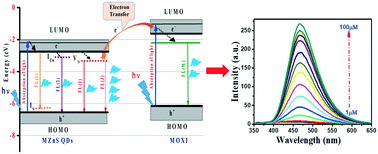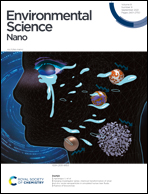Enhanced fluorescence of mercaptopropionic acid-capped zinc sulfide quantum dots with moxifloxacin in food and water samples via reductive photoinduced electron transfer†
Abstract
Fluorescence is a promising technique adopted in a large number of optical sensing probes. In this study, a facile and rapid fluorometric 3-mercaptopropionic acid-capped zinc sulfide (MZnS) quantum dot (QD)-based nanosensor is reported for the specific detection of moxifloxacin (MOXI). Trioctylphosphine-capped ZnS (TOP-ZnS) QDs were synthesized by a hot injection method followed by a ligand exchange process to make water-soluble MZnS QDs suitable for biological applications. Transmission electron microscopic analysis exhibited monodisperse TOP-ZnS and MZnSQDs with average sizes of 2.11 ± 1.47 nm and 2.52 ± 0.89 nm, respectively with excitation wavelength dependent blue fluorescence (FL) emission property. Under optimum conditions, the FL intensity of QDs enhanced 41.3-fold with MOXI concentrations due to the reductive photoinduced electron transfer (PET) mechanism. With the developed nanosensor, MOXI can be quantified in a 1–100 μM concentration range with a lower detection limit of 0.203 μM. The proposed nanosensor was successfully applied to determine MOXI in real samples and can potentially be used in environmental and food safety applications.



 Please wait while we load your content...
Please wait while we load your content...